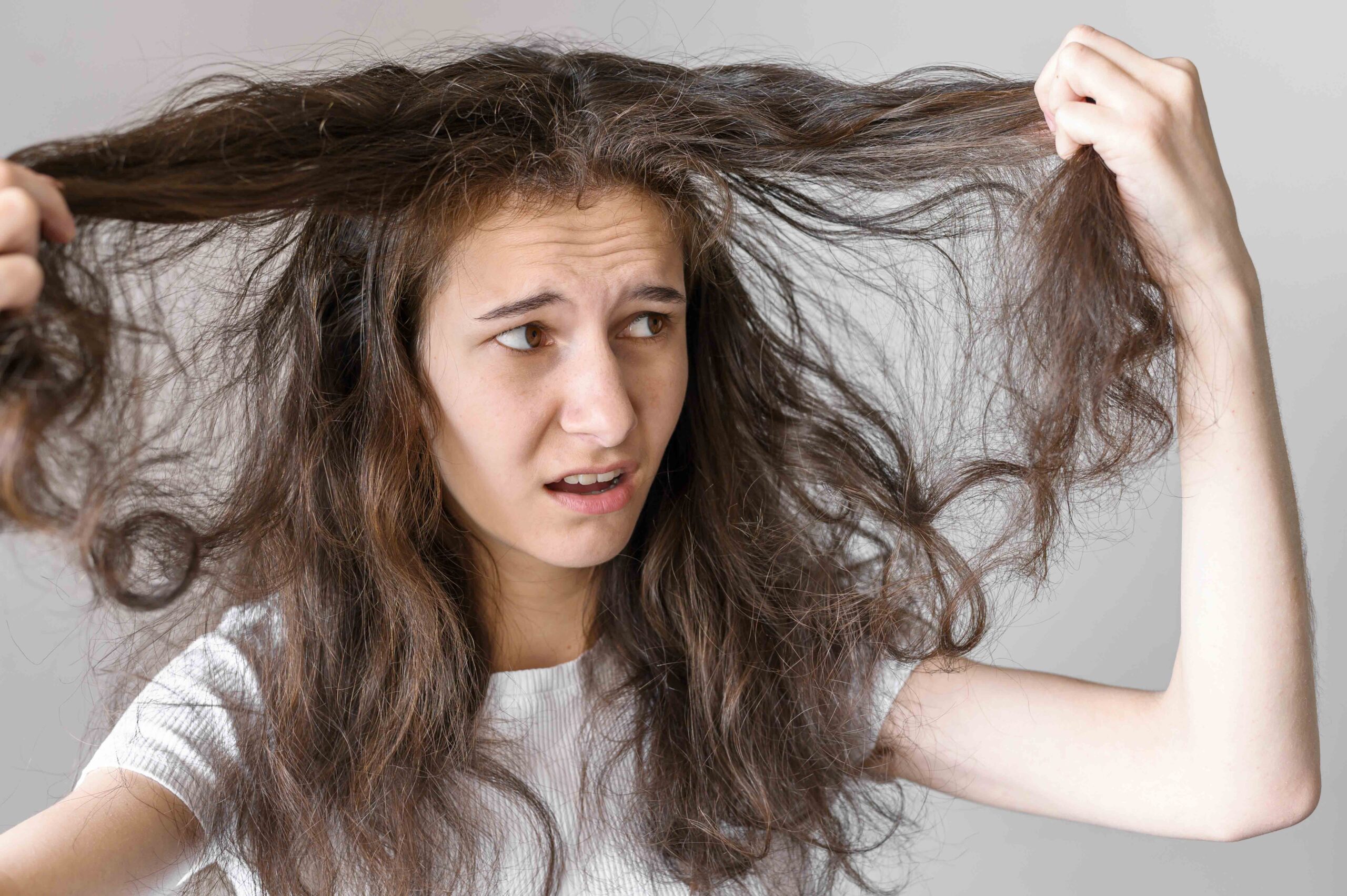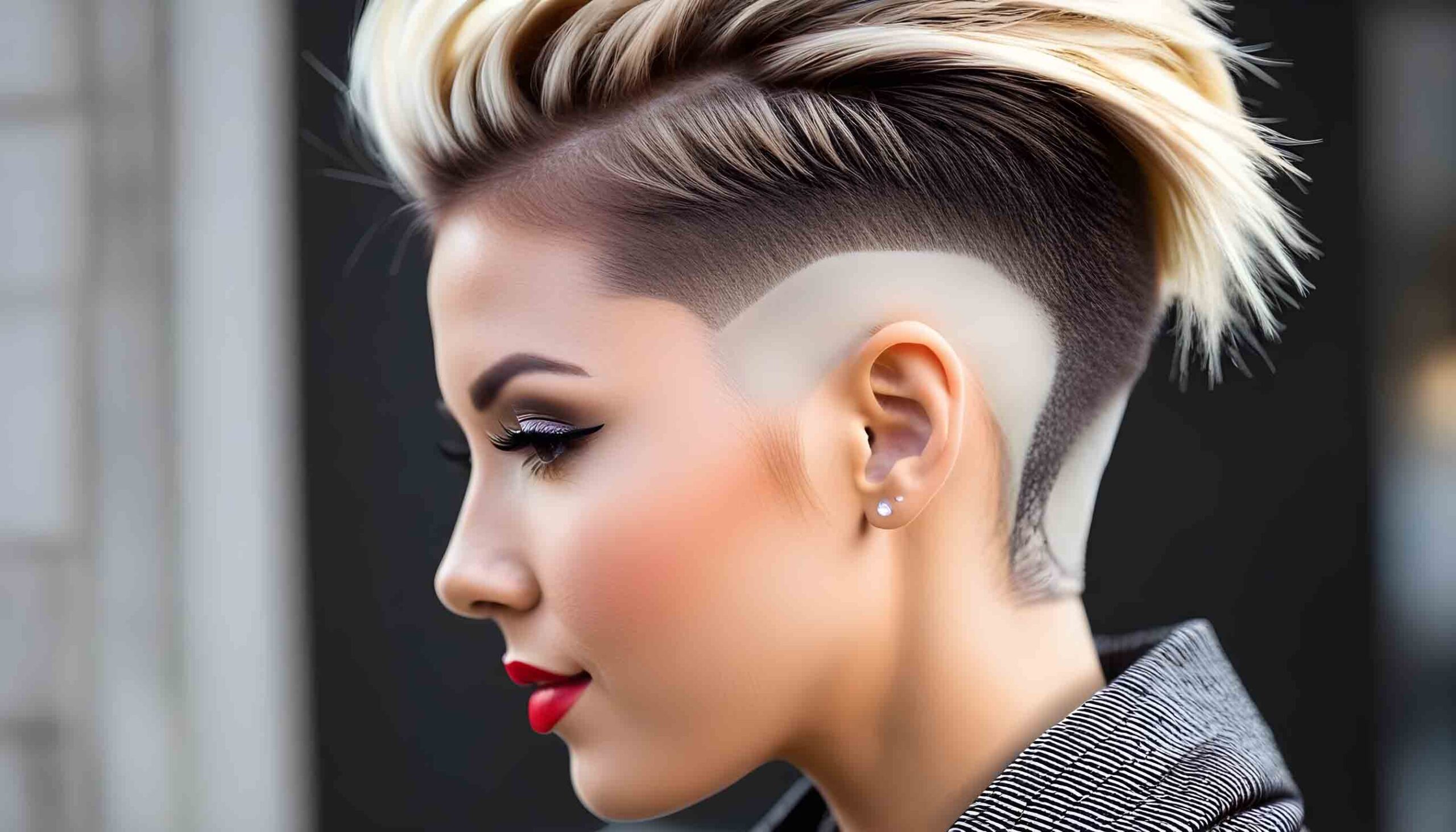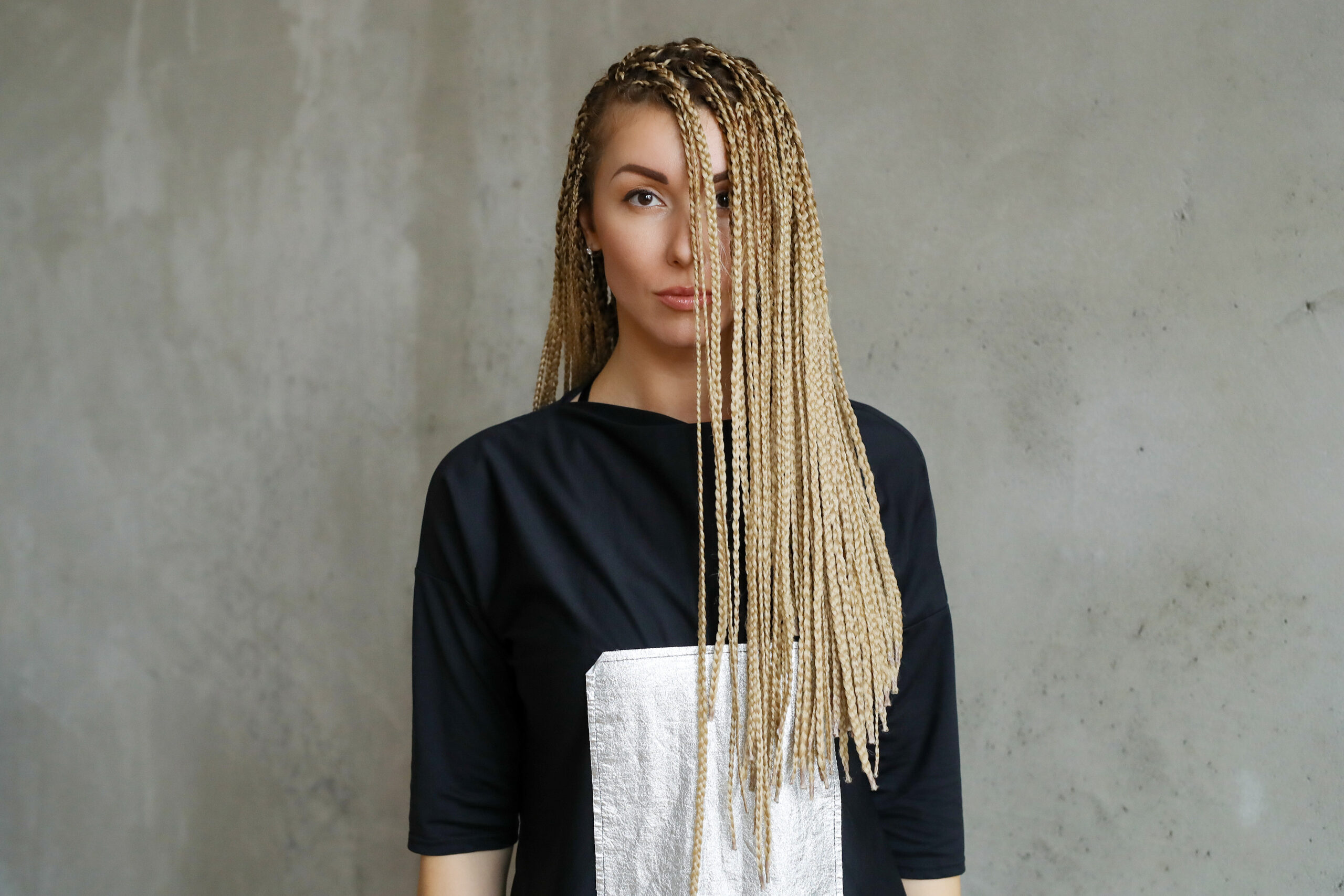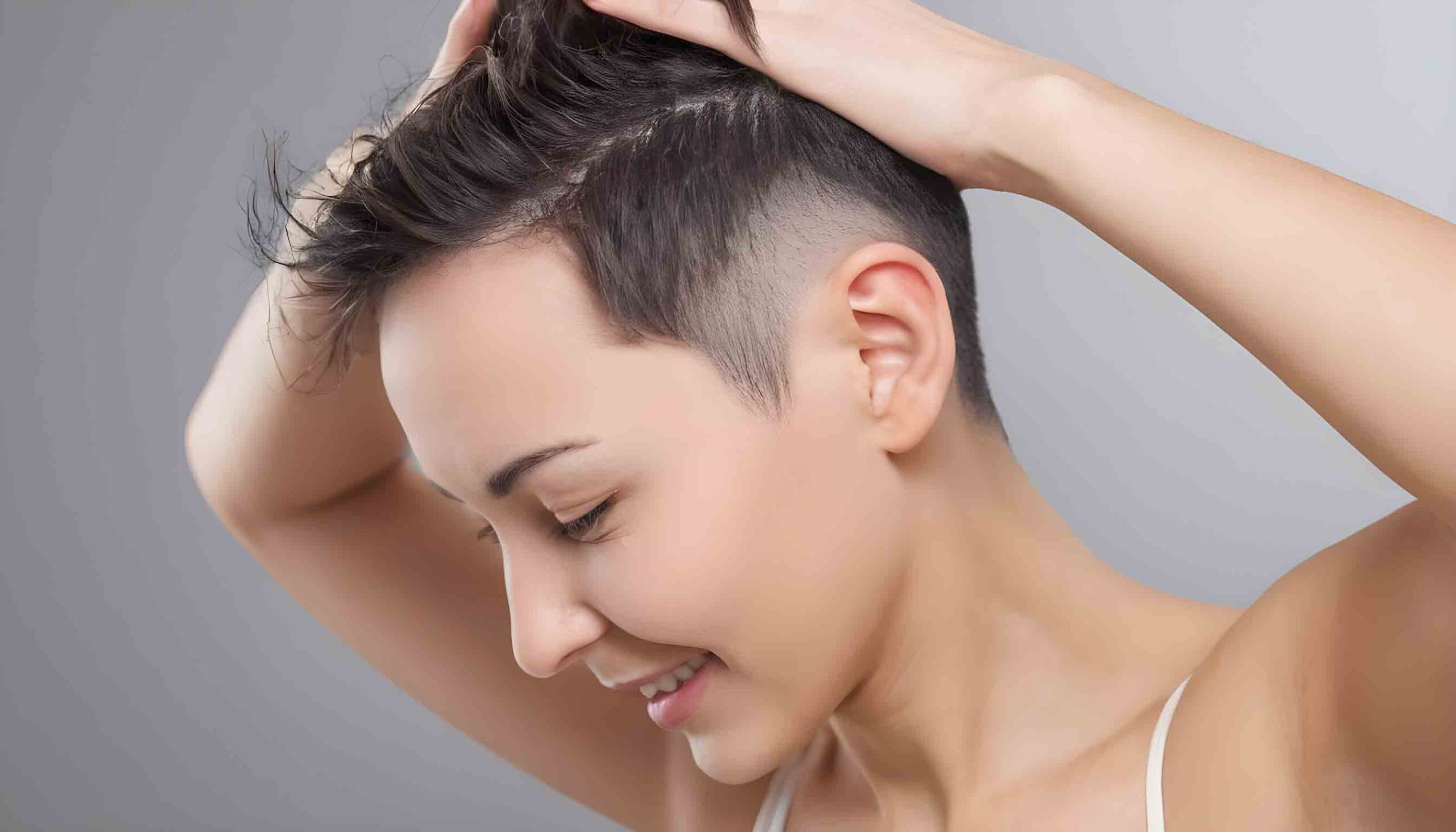What Is Damaged Hair?
Damaged hair is hair that has lost its natural integrity and healthy structure due to various factors. Hair is made up of a protein called keratin arranged in bundles called follicles. The outermost layer, known as the cuticle, is composed of shingle-like overlapping scales that protect the inner structure.
When the hair cuticle becomes compromised, the cortex underneath loses its strength and elasticity. This makes hair prone to breakage, dryness, frizz, and overall lackluster appearance.
Damaged hair can manifest in various ways, including:
Dull And Dry Hair
Healthy hair has a natural luster and sheen. Dull hair lacks vibrancy and appears lifeless. This is often accompanied by dryness, which stems from a lack of moisture. Dry, rough hair feels coarse to the touch.
Dull, dry hair is unable to properly reflect light, causing it to look flat and faded. Lack of moisture causes the cuticle to lift and the hair shaft to become porous.
Tangles
Tangles occur when the protective cuticle layer gets disrupted. This causes the cortex to snag and knot. Detangling damaged, tangled hair usually causes more breakage.
Frizz
Frizz happens when the flattened cuticle layer gets disturbed, causing the hair shaft to become rough. This makes hair refract light unevenly, creating a fuzzy appearance.
Humidity expands the hair cuticle, worsening frizz. Using heating tools excessively also causes cuticle damage.
Brittleness And Breakage
Brittle hair is dry, fragile hair prone to snapping. The protective lipid layer that coats the cuticle gets stripped away by damage.
Lack of moisture causes the hydrogen bonds in keratin to weaken. This makes hair brittle and snap when combed or styled.
What Causes Hair Damage?
Several factors compromise the structure of hair, causing varying degrees of damage:
Heat Styling
Frequent heating tools like blowdryers, curling irons, and straighteners can boil moisture out of the hair. This leads to dry, brittle hair prone to breakage.
High temperatures also disrupt and fuse the hair’s keratin bonds. This leads to split ends and frizziness.
Bleaching
Bleach oxidizes and deaminates the melanin pigment in hair, causing significant protein loss. This makes hair extremely porous and fragile.
Chemical Dyes
Chemical hair dye utilizes peroxide to open the cuticle and alter the color. Repeated dyeing causes cumulative damage by stripping lipids and keratin.
Improper Detangling
Aggressive brushing, backcombing, detangling stress, and pulling hair. This disturbs the protective cuticle.
Sun Exposure
UV rays degrade hair protein and strip away moisture leading to dry, brittle hair prone to breakage.
Chlorine and Saltwater
Chlorine from pools and salt from ocean water can corrode and dry out the hair cuticle. This causes brittleness.
Heat Styling Without Protection
Using heating tools without a heat-protecting product can scald the hair and cause protein loss.
Infrequent Trimming
Avoiding regular trims allows split ends to travel up the hair shaft, causing more splits and breakage.
Rough Towel Drying
Vigorously rubbing wet hair with a towel creates tangles, frizz, and cuticle damage.
Tight Hairstyles
Tight braids, cornrows, hair extensions, and ponytails strain and pull on hair follicles leading to trauma and loss.
Nutritional Deficiencies
Diets deficient in protein, vitamins, minerals, and essential fatty acids can compromise the integrity of the hair shaft.
Aging
Aging causes the hair shaft’s diameter to thin over time, making it more vulnerable to damage.
Medical Conditions
Diseases that lead to inflammation or hormone imbalances can affect hair growth cycles leading to damage.
How Do You Treat Damaged Hair?
Treating damaged hair focuses on repairing and protecting the hair shaft. This involves adding protein and moisture through conditioners. Oils seal the cuticle to restore shine and smoothness. Here are some tips:
Hair Care Routine
Shampoo less often and use a gentle, moisturizing shampoo. Limit the use of heating tools. Avoid rubber bands, tight styles, and harsh brushes.
Apply Hair Serum
Look for nutrient-rich serums containing oils, proteins, ceramides, and silicone to nourish hair and seal the cuticle.
Trim Your Hair
Get regular trims to snip away split ends before they travel further up the hair shaft. Avoid trimming too often.
Homemade Masks
Make regular nourishing masks using oils like coconut, olive, almond, or argan along with eggs, yogurt, honey, banana, etc.
Hair Oils
Massage oils like coconut, almond, olive, and jojoba into your hair and scalp. Leave it on overnight and wash it out the next morning.
Tips To Control Your Hair Damage
Here are some tips to minimize and prevent further hair damage:
Mechanical Damage
- Avoid aggressive brushing, tight hairstyles, and rough drying.
- Use wide-toothed combs and natural bristle brushes.
- Allow hair to air dry when possible.
Chemical Damage
- Space out chemical treatments like dying, straightening, and perming.
- Use oils, and conditioning treatments to replenish moisture.
- Use lower volume developer with hair color.
Heat Damage
- Allow hair to air dry or rough dry with a towel before heat styling.
- Use thermal protecting sprays, creams, or serums before using hot tools.
- Keep heat tools in medium or low heat settings.
Lower the Temperature on Your Tools
Set your blow dryer, curling iron, and straightener on medium or the lowest heat setting suitable for your hair type. This helps prevent protein loss.
Handle Wet Hair with Care
Avoid brushing or rubbing wet hair vigorously. Use a wide-toothed comb gently on damp hair to prevent stretching and breakage.
Indulge in Rich and Healing Hair Masks
Give your hair an intensive moisture treatment with a hydrating hair mask once a week. Look for ingredients like oils, shea butter, glycerin, and honey.
Embrace Leave-Ins
Leave-in conditioners reinforce hair’s protein bonds and provide lasting hydration and heat protection. Focus on moisture-binding ingredients.
Get Professional Treatments
In-salon strengthening and conditioning treatments can help restore damaged hair. These contain concentrated proteins, oils, and bond-building ingredients.
Mind Your Bonds
Bond-building products reinforce hair’s disulfide bonds and increase elasticity and strength. Olaplex and Brazilian B3 Perfection are popular options.
Trim Your Split Ends
Get regular trims every 6-8 weeks to snip away split ends and allow healthy hair to grow out. Avoid over-trimming.
Swim and Sun with Care
Apply a protective swim cap before swimming. Use leave-in conditioners and UV-protecting products to shield against sun damage.
Don’t Let Your Hair Get Thirsty
Hydrate hair daily with moisturizing shampoos, masks, and leave-ins. Oils help seal in moisture. Humectants attract and bind water.
Shampoo Wisely and Well
Use lukewarm water and sulfate-free shampoos to avoid leaching moisture. Limit shampooing to twice a week and focus shampoo on the scalp.
Recognizing Damaged Hair
It’s important to identify signs of damage early so you can take corrective action before it worsens. Here are tips on recognizing common types of hair damage:
Recognizing Tangled Hair
- Noticeable increase in tangles and knots especially when wet
- Hair feels rough and bumpy to the touch
- Combing leads to more tangling instead of smoothing
- Need to constantly use conditioner to comb wet hair
Identifying Dull and Dry Hair
- Hair lacks shine and vibrancy
- Feels rough, frizzy and straw-like
- Hard to manage and style
- Unresponsive to conditioning and seems perpetually dry
- Prone to static and flyaways
Recognizing Fried and Frizzy Hair
- Hair appears kinky, frizzy, or fuzzy
- Refracts light unevenly creating a halo effect
- Cuticle damage causes strands to separate and stick out
- Seems ultra-dry and thirsty for moisture
- Frizz worsens with humidity
Recognizing Brittle and Breaking Hair
- Hair feels dry, coarse, and rough
- Makes crunching or squeaking sounds when rubbed together
- Breaks easily with simple styling, brushing, or washing
- Noticeable increase in hair fall and broken hairs
- Split ends start to travel up the hair shaft
- Hair feels gummy or sticky when wet
Can Damaged Hair Be Repaired?
Repairing damaged hair often requires a combination of temporary and permanent solutions depending on the type and degree of damage.
Permanent vs. Temporary Solutions
Severely damaged hair cannot return to its original undamaged state. The goal is to strengthen hair and prevent further damage. Temporary solutions improve texture and appearance but don’t permanently undo the damage.
The Role of Time and Prevention
Letting hair rest and grow out while avoiding stressors allows healthy new growth to replace damaged hair. Consistent hair care and protective measures help support and maintain hair health.
Preventing Further Damage
The key is stopping the cycle of damage. Altering damaging hair care habits and routines while incorporating protective ones prevents more harm.
Strategies for Dye Users
- Wait 6-8 weeks between color treatments
- Use semi-permanent or demi-permanent dyes
- Perform a patch test before dyeing hair
- Apply oil or treatment before and after coloring
- Use lower volume developer with hair dye
Best Practices for Bleached Hair
- Get bleaching done professionally
- Wait 12 weeks between bleaching sessions
- Use purple shampoo to reduce brassiness
- Avoid heat styling and tying hair tight
- Use bond-building and strengthening treatments
Tips for Safe Heat Tool Usage
- Allow hair to air dry partially before using hot tools
- Always use a thermal protectant product
- Keep heat settings on low or medium
- Avoid placing hot tools directly on the scalp
- Alternate heat styling with air-drying
Importance of Regular Haircuts
- Get a modest trim every 6-8 weeks
- Schedule regular dusting appointments with the stylist
- Inform the stylist if the hair is damaged so they can customize the trim
- Avoid trimming hair when it’s wet
Targeted Treatments and Remedies
For Dry/Brittle Hair: Nourishing oils, protein treatments, leave-in conditioners, overnight masks
For Heat Damage: Bond-building treatments, keratin treatment, lower heat settings
For Chemical Damage: Clarifying shampoos, moisturizing masks, Olaplex treatment
For Mechanical Damage: Protective styles, loose braids, silk scrunchies, satin pillowcases
Using Oils for Hair Repair
Massaging oils like coconut, olive, and almond into hair and letting it sit overnight allows deep penetration to hydrate and strengthen hair from within.
Choosing Color-Safe Products
Opt for sulfate-free, protein-enriched shampoos, and deep conditioners specially formulated for color-treated hair. Avoid anti-dandruff shampoos.
Moisturizing Techniques for Bleached Hair
Bleached hair needs extra moisture. Use weekly nourishing masks, leave-in conditioners, spritzes, and creams containing oils, panthenol, and ceramides.
Heat Protection and Alternatives
Prep hair with thermal protecting sprays, serums, or creams before heat styling. Allow hair to air dry partially before using hot tools. Go heatless when possible.
Specific Causes and Solutions
It’s important to identify factors causing and contributing to damage so you can tailor solutions accordingly:
Damage from Dye: Prevention and Recovery
- Wait longer between dye jobs
- Use semi-permanent or demi-permanent options
- Perform allergy testing before dyeing
- Apply oil before and mask after coloring
- Rotate using protein and moisture treatments
Coping with Bleached Hair: Tips and Products
- Use lower volume developer with bleach
- Incorporate Olaplex into bleaching routine
- Avoid heat styling and tight hairstyles
- Use bond-building and repairing treatments
- Shampoo less and use purple shampoo for brassiness
Mitigating Heat Tool Damage: Guidelines
- Apply a heat protectant before using hot tools
- Keep heat settings low or medium
- Allow hair to air dry partially before heat styling
- Take breaks from hot tools and allow hair to rest
- Use no-heat curls and styles when possible
Importance of Regular Haircuts: Recommendations
- Get trims every 6-8 weeks to snip split ends
- Seek stylist guidance on managing damaged hair
- Request dusting trims instead of taking off the length
- Schedule trims right before a big event
- Time trims with the moon cycle for optimal results
Addressing Unidentified Hair Issues
Troubleshooting unclear hair damage:
- Assess hair care routine and habits
- Look for signs of deficiency like dullness or dryness
- Identify possible medical causes
- Seek professional guidance from a stylist
- Get lab testing done for nutritional deficiencies
Tackling Tangled Hair Problems
- Use slippery conditioners and detangling sprays
- Comb through tangles gently before washing
- Avoid rough drying and brushing
- Use microfiber towels and wide-toothed combs
- Try leave-in treatments and silicone serums
Solutions for Dull and Dry Hair
- Deep condition with masks weekly
- Apply oil or serum concentrating on the ends
- Switch to a hydrating shampoo and conditioner
- Cut back on heat styling to prevent protein loss
- Get regular trims to restore shine
Managing Fried and Frizzy Hair
- Use products focused on sealing the cuticle
- Incorporate ant-humectants and anti-frizz serums
- Avoid brushing or touching hair while damp
- Apply styling creams or oils when wet
- Reduce heat styling to prevent further cuticle damage
Strategies for Brittle and Breaking Hair
- Use strengthening treatments and bond builders
- Shampoo less and condition more
- Handle hair gently and avoid tight styles
- Seal in moisture with oils and serums
- Protect hair from sun exposure and chlorine
Practical Tips for Hair Maintenance
Adopting the right hair care practices helps support hair health and prevent damage:
Brushing and Detangling Techniques
- Use a wide-toothed comb or wet brush
- Start from the bottom and gently work upwards
- Apply conditioner or detangling spray beforehand
- Detangle hair before washing and avoid brushing wet
Effective Hair Washing Habits
- Use lukewarm water and limit washing to 2-3 times a week
- Focus shampoo on the scalp and conditioner on the lengths
- Dilute shampoo to reduce lather and stripping
- Rinse hair thoroughly with cool water to seal cuticles
Choosing the Right Shampoo and Conditioner
- Opt for a gentle hydrating shampoo
- Use a thick conditioner matched to your hair needs
- Look for strengthening proteins and amino acids
- Ensure adequate cleansing without over-stripping
Incorporating Hydrating Oils into Your Routine
- Apply oil on damp hair before washing
- Use oil to seal in moisture after styling
- Try a weekly hot oil treatment
- Massage oils like coconut into the scalp
Seeking Professional Advice
Consulting trichologists and dermatologists can help identify causes and customize solutions for damaged hair:
When to Consult a Hair Professional
See a trichologist or hair stylist if you notice:
- Sudden increase in shedding or breakage
- No improvement despite at-home treatments
- Scalp issues like redness, itching, or dandruff
- Hair feels gummy or stretches when wet
Importance of Dermatological Assessment
See a dermatologist if you suspect:
- An underlying medical condition
- Nutritional deficiency or hormone imbalance
- Adverse reaction to hair products
- Scalp infection or inflammation
- Alopecia or balding
Dealing With Heat Damaged Hair
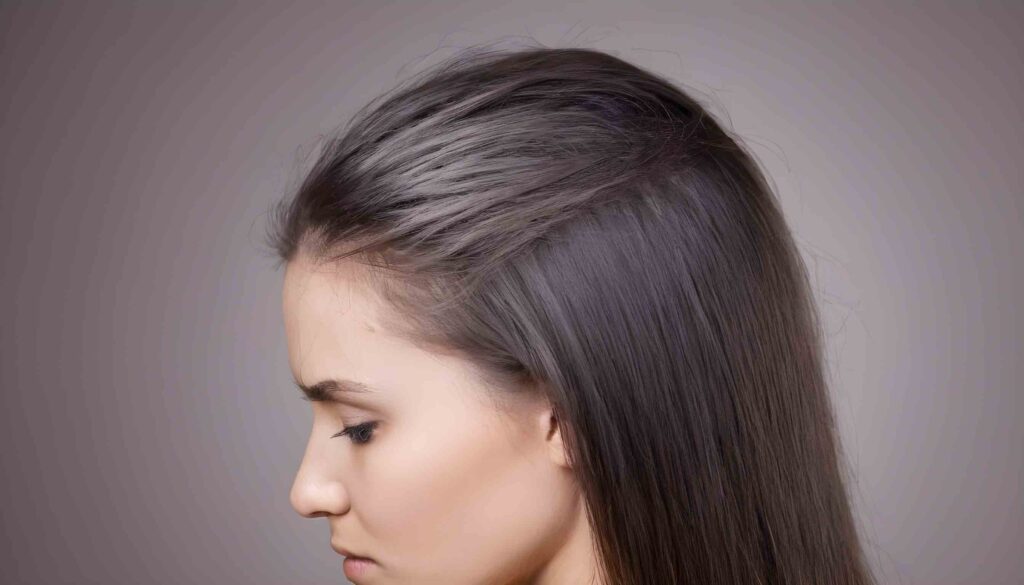
Heat tools like blow dryers, curling irons, and straighteners can seriously damage hair when used improperly and excessively. The high temperatures boil the moisture out of the hair cuticle, leaving strands dry and brittle. Frequent heat styling causes the hydrogen bonds in keratin to break down, leading to protein loss. This makes hair prone to frizz, tangling, dullness, and breakage.
It’s important to take preventative steps to avoid heat damage. Always prep hair with a thermal protecting spray, cream or serum before using hot tools. This provides a barrier against the intense heat. Opt for formulas containing nourishing ingredients like argan oil, glycerin, and keratin to condition hair. Allow hair to air dry partially before using heat tools. This prevents the water inside from boiling and scalding hair. Keep the heat settings on your tools low or medium. Passing hot irons slowly also minimizes exposure to high temperatures.
In addition, space out heat styling and take breaks to allow hair to rest. Avoid repeatedly applying heat to the same sections to prevent excessive damage. Alternate heat styling with air drying when possible. This allows the hydrogen bonds broken by heat to re-form. Deep condition hair weekly with a hydrating mask to combat dryness and nourish strands. Oils like coconut and olive also help replenish moisture and smooth down the cuticle. Getting occasional trims snips away split ends and allows you to maintain the length.
If you already have heat damage, bond-building treatments containing hydrolyzed keratin and proteins help reconstruct the weakened bonds. Moisture is key, so incorporate repairing masks, leave-ins and oils into your routine. Go easy on hot tools and switch to gentler styling methods while hair recovers. With time and diligent care, your strands can bounce back from heat abuse. The key is being proactive about prevention.
Hair Treatments For Damaged Hair
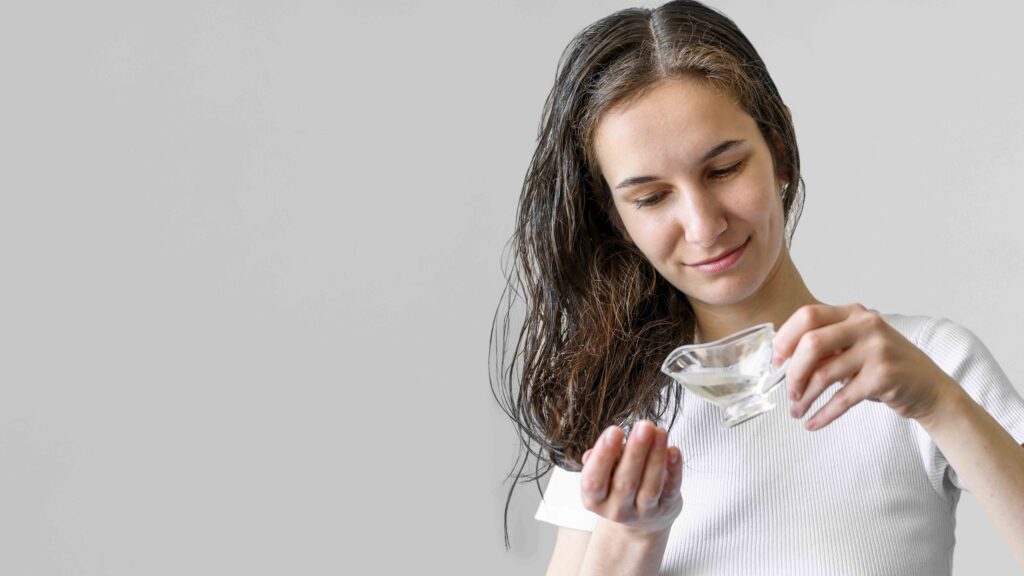
Damaged hair needs special care and treatment to restore its health and shine. Certain ingredients actively work to repair broken bonds, provide moisture, and strengthen the hair cuticle.
Look for products containing proteins like keratin, wheat protein, and amino acids which reinforce the hair structure. Oils like coconut, olive, argan, and jojoba are deeply conditioned to improve softness and elasticity.
Silicones like dimethicone coat the hair to reduce friction, seal in moisture, and add shine. Humectants like glycerin, honey, and panthenol attract and bind hydration into the strands.
Deep conditioning masks provide an intensive moisture treatment for damaged hair. Opt for formulas with nourishing oils and butter like shea and cocoa. Allow the mask to penetrate for 30 minutes with heat from a dryer or heating cap.
Multi-step professional treatments like the Brazilian Blowout, Keratin Complex, and Design Essentials strengthen and smooth hair. They use hydrating cleansers, masks, and a neutralizing serum.
Olaplex has revolutionized bond-building technology. It contains bis-aminopropyl diglycol dimaleate which works to repair broken disulfide bonds. This noticeably improves elasticity, and texture and reduces breakage.
Similarly, Brazilian B3 Perfection by Cadiveu uses an Amino Kera-Nouveau complex to reconstruct inner hair bonds. It reverses oxidation and reconditions damaged cuticles.
Rice water rinses are an age-old remedy for damaged hair. The protein-rich water deposits amino acids and strengthens strands. Ensure proper preparation for best results.
Homemade hair masks using avocado, banana, egg, yogurt, and oils nourish deeply and reverse dryness. Leave on for 20-30 minutes before washing out.
With consistent use of targeted treatments, damaged hair can regain its health. Being gentle, using protective styles and getting occasional trims helps maintain the results.
Finding the Best Shampoo for Damaged Hair: A Comprehensive Guide
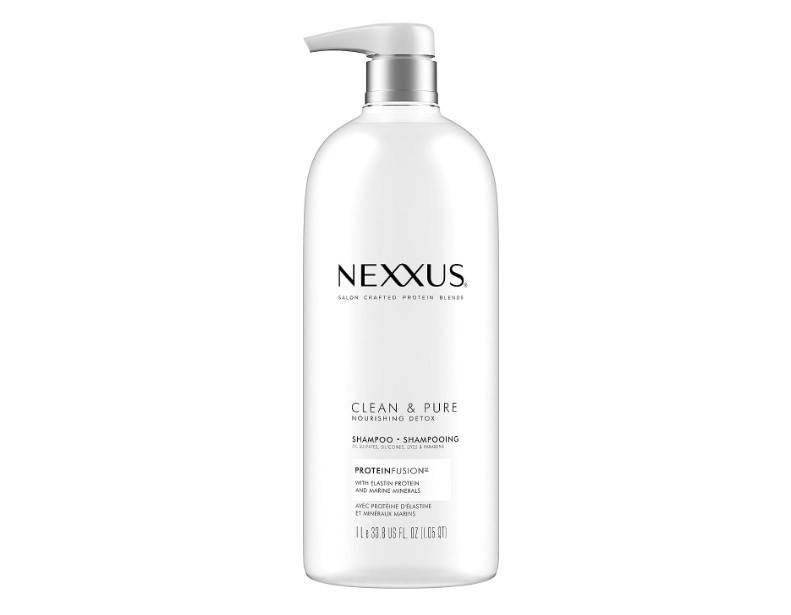
If you’ve been struggling with damaged hair, fret not; there’s a world of effective solutions waiting for you. The key to restoring your hair’s health lies in choosing the right products and incorporating essential techniques into your hair care routine. In this guide, we explore the best shampoo for damaged hair, along with a plethora of LSI words encompassing hair care, treatment, and maintenance.
Hair Care and Maintenance:
When dealing with damaged hair, it’s crucial to adopt a comprehensive hair care routine. Regular haircuts help prevent split ends and maintain the overall health of your hair. A skilled hairdresser can guide you on the best cuticle care and recommend at-home hair care practices that contribute to hair restoration.
Effective Hair Treatment:
The market is flooded with an array of hair products designed to combat damage and nourish your locks. Look for shampoos enriched with natural oils such as olive oil, coconut oil, jojoba oil, and almond oil. These ingredients provide deep hydration, promoting hair health and preventing breakage.
UV Protection and Frizz Control:
UV protection is often an overlooked aspect of hair care. Exposure to the sun can lead to color fading and increased hair damage. Opt for shampoos that offer UV protection, ensuring your hair remains vibrant and healthy. Additionally, choose products that control frizz, giving your hair a smooth and polished appearance.
Hydration and Moisturizing:
Proper hydration is vital for damaged hair. Incorporate hydrating hair masks, conditioners, and moisturizing shampoos into your routine. Natural oils are excellent for restoring moisture, combating dryness, and enhancing your hair’s texture.
Hair Styling Tips:
Beyond choosing the right products, implementing proper hairstyling tips is essential. Be mindful of heat styling, use detangling techniques, and adopt gentle hair brushing practices. Following these techniques, along with the best shampoo for damaged hair, will set you on the path to revitalized and healthy locks.
In conclusion, a holistic approach to damaged hair repair involves a combination of quality products and mindful hair care techniques. Explore the world of hair restoration, armed with the right information and the best products tailored to your needs.
Nourishing Your Locks: The Best Shampoo and Conditioner for Damaged Hair
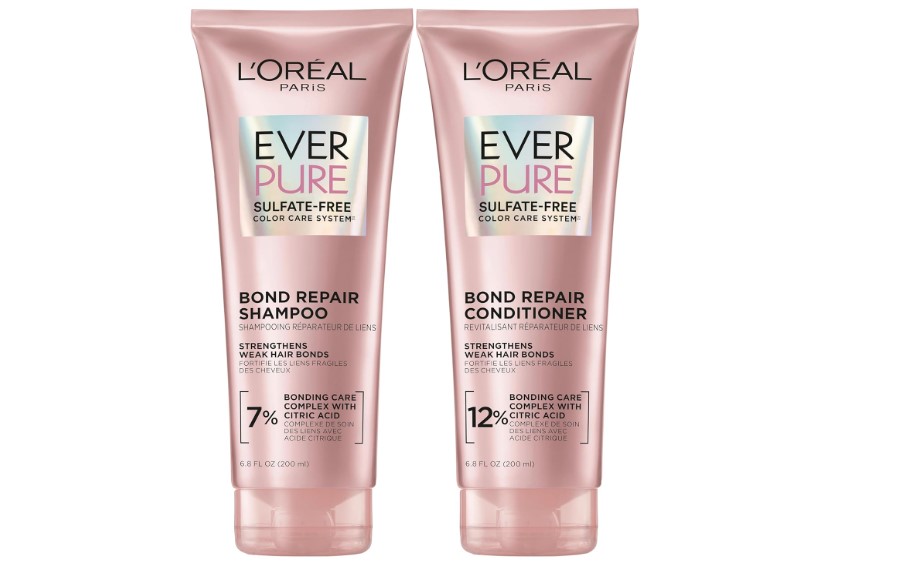
Reviving damaged hair requires a strategic approach to hair care, and choosing the right shampoo and conditioner is paramount. Explore the world of hair health with our guide to the best products enriched with natural oils and essential ingredients that cater to damaged hair repair.
Hair Care Revolution:
Embark on a hair care revolution by selecting the best shampoo and conditioner for damaged hair. These products play a crucial role in your hair care routine, addressing issues such as split ends, breakage, and lackluster hair health.
Natural Oils and Ingredients:
Look for products infused with olive oil, coconut oil, jojoba oil, and almond oil. These natural oils provide intense hydration, promoting hair health and preventing further damage. The combination of these ingredients in your shampoo and conditioner ensures a nourishing experience for your locks.
Hair Damage Prevention:
Beyond repair, prevention is key to maintaining healthy hair. The best shampoo and conditioner for damaged hair offer a protective shield against external factors like UV rays, heat styling, and hair bleaching. Incorporate these products into your routine to safeguard your hair from potential damage.
Hair Maintenance and Restoration:
Incorporating a hair care routine that includes the best shampoo and conditioner aids in the maintenance and restoration of your hair. Regular use of these products, complemented by at-home hair care practices, contributes to a healthier and more vibrant mane.
Styling and Protection:
Opt for a shampoo and conditioner duo that not only repairs but also aids in styling. Combat frizz, enhance texture, and promote a glossy finish with products designed for both protection and styling.
In conclusion, the journey to restoring damaged hair begins with the right products. The best shampoo and conditioner for damaged hair, enriched with natural oils and protective ingredients, sets the foundation for a rejuvenated and resilient mane. Elevate your hair care routine with these essential products tailored for damaged hair repair.
Frequently Asked Questions About Damaged Hair
How do you treat damaged hair?
Use a gentle moisturizing shampoo, conditioner, masks, oils, leave-ins, and treatments focused on strengthening hair and sealing the cuticle. Reduce heat and chemical treatments. Get regular trims.
Can you actually repair damaged hair?
Severe damage cannot be completely reversed. However, strengthening treatments, bond builders, and moisture can improve hair’s appearance and texture. Avoiding further damage allows new healthy growth.
Can damaged hair go back to normal?
Hair that is mildly damaged can revert close to normal over time with diligent care and protective measures. Once the hair fiber is severely compromised, the damage is permanent.
How can I tell if my hair is damaged?
Signs like dryness, dullness, tangling, frizz, split ends, and breakage indicate damage. Hair may feel rough and coarse to the touch. It can appear lifeless, fuzzy, and unruly.
How do you fix damaged hair from heat?
Regular use of heat-protecting sprays before styling can help prevent further damage. Bond-building treatments help repair bonds weakened by heat. Minimize the use of hot tools and keep them on low settings.
How can I tell if my hair is heat damaged?
Frequent use of hot tools causes cuticle damage, leading to frizz, dryness, lackluster appearance, and breakage. Hair starts feeling coarse, straw-like, and tangled.
How long does it take for heat damaged hair to repair?
With diligent hair care it can take 2-3 months to rehabilitate heat damaged hair. Avoid heat styling during this time. Focus on moisture, protein treatments, and bond builders. Trim split ends.
Is heat damage permanent hair?
Severe heat damage that causes significant protein loss and cuticle lifting cannot be reversed. However, limiting heat use and following repairing treatments can improve texture.
Which hair treatment is best for damaged hair?
Deep conditioning masks, leave-in treatments, oils, and serums containing proteins, fatty acids, and humectants help strengthen and restore damaged hair. Olaplex is excellent for fixing bonds.
How can I heal my damaged hair?
Improve damaged hair by pre-pooing with oils, using repairing shampoos and masks, incorporating leave-ins, trying rice water rinses, minimizing heat styling, getting trims, and using silk accessories.
How can I fix my damaged natural hair?
Focus on keeping natural hair conditioned and moisturized. Use a non-stripping shampoo, hydrating masks, leave-ins, oils, serums, and satin bonnets. Avoid heat styling, brushing when dry, and manipulation when wet.
What is the best treatment for hair breakage?
For breakage and split ends, bond-building treatments like Olaplex or Brazilian B3 Perfection Smooth are highly effective. Corrective keratin treatments can also help strengthen and repair broken hair.
What is the best shampoo to restore hair?
Look for shampoos containing proteins like keratin, amino acids, or wheat protein along with nourishing oils and moisturizing ingredients like glycerin and shea butter. Shiru Wan and Nexxus Diametress are great options.
Which is the best shampoo for dry hair?
Some top shampoos for dry, damaged hair include Briogeo Don’t Despair Repair, Pureology Hydrate Shampoo, Moroccanoil Hydrating Shampoo, Living Proof Restore Shampoo, and Redken Extreme Shampoo.
Can shampoo really repair damaged hair?
Shampoos cannot completely fix or reverse the damage. However, the right formula can help strengthen hair, boost moisture, and protect against future damage. Look for ingredients like keratin, amino acids, oils, etc.
What are the top 10 shampoos?
Some top-rated shampoos for damaged hair are Olaplex No.4, Pureology Hydrate, Briogeo Don’t Despair Repair, Moroccanoil Hydrating, Living Proof Restore, Pureology Strength Cure, Redken Extreme, DevaCurl No-Poo, R+Co Dallas, and IGK Good Behavior.
Which shampoo is best for damaged hair?
Top shampoos for damaged hair include Olaplex 4, Briogeo Don’t Despair Repair, Pureology Hydrate, Living Proof Restore, Nexxus Diametress, Redken Extreme, Moroccanoil Hydrating, DevaCurl No-Poo, Alterna Caviar Anti-Aging, and R+Co Dallas.
What shampoo and conditioner is best for hair breakage?
For reducing hair breakage, try Olaplex 4 and 5 shampoo and conditioner, Briogeo Don’t Despair Repair, Pureology Strength Cure, Redken Extreme, Living Proof Restore, It’s A 10 Miracle Shampoo, DevaCurl Decadence Conditioner or Mask, R+Co Dallas Thickening.
What is the best professional shampoo for dry damaged hair?
Top salon shampoos for dry, damaged hair include Olaplex No.4 Bond Maintenance Shampoo, R+Co Dallas Thickening Shampoo, Pureology Hydrate Sheer Shampoo, Redken Extreme Shampoo, Schwarzkopf BC Bonacure Repair Rescue Shampoo, and L’anza Healing Strength Neem Plant Based Shampoo.
What shampoo is recommended most to address damaged hair?
Olaplex No.4 Bond Maintenance Shampoo is highly recommended by hair stylists and experts for repairing damage and preventing breakage. It contains active ingredients that rebuild broken disulfide bonds.

